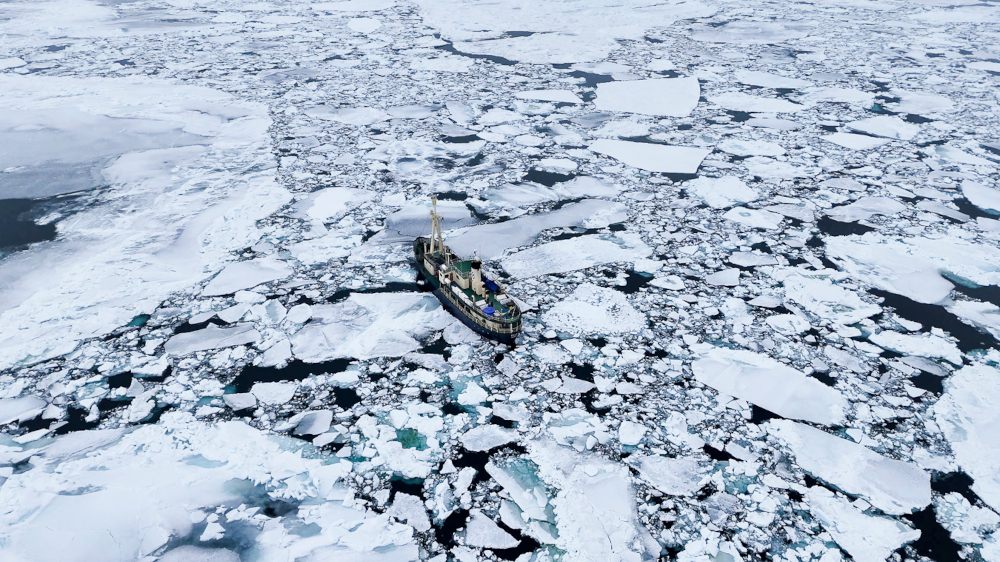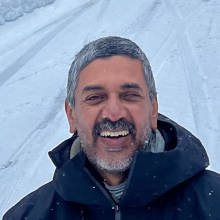[Amidst a million broken pieces of glass, in Svalbard, Norway]
Surreal.
That was the word that came to my mind.
I hunched my shoulders, pushed my curled fists deeper into my pockets, searching for some non-existent warmth and looked around me.
There were a million broken pieces of ice all around me for as far as I could see. It felt as if I was trapped in a sea of broken glass. It was a little past four in the morning, early in June and the sun was hovering around the horizon, which it will continue to do for the whole day and night.
There was a slight breeze blowing, which made the temperature feel even lower than what the reading showed. We were far away from land, I could not see the familiar flattened shapes of the hills anywhere around me. There were no black guillemots flying and crash landing around me. Even the northern fulmar, which is the one bird that usually gives us company in remote places, was nowhere to be seen.
We were alone. We were in the middle of nowhere.
I was on board the M/S Origo, a 70-year-old ship that sailed the waters in the Arctic. Origo was much smaller compared to the usual cruise ships, around 40m long and less than 10m wide with the capacity to carry just 12 passengers.
Right now, Origo was in Svalbard, beyond 80 degrees north, just a thousand miles or so from the North Pole.
Far away, impossible to see with naked eyes, was a polar bear with her cub. We had been waiting at this spot to see if she would eventually become curious enough to come closer to inspect us, or, whether the inherent caution of a young mother would persuade her to stay away.
As is often in such situations, untrammeled by any immediate constraints or the need for decisions to be made, the mind roams. I wondered how many people would have traveled this far north. How many of those who had come here would have repeated such a trip.
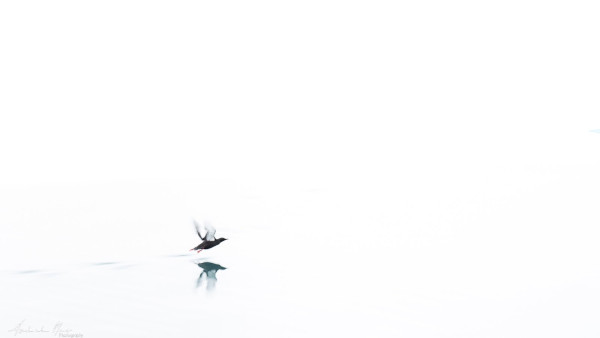
[A guillemot takes off]
Even five years back if someone would have suggested that I would be amongst that unimaginably small number of people to come this far up north twice, I would have found the notion insane.
And, yet, here I was.
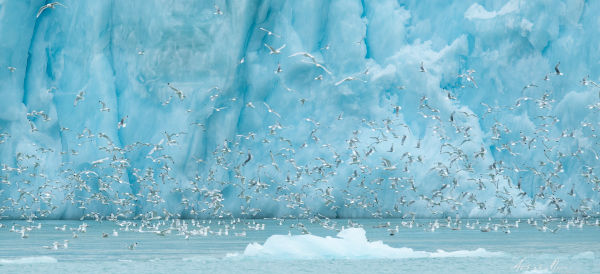
[A moment of unforgettable delight as a flock of gulls, terns and other birds take flight against the backdrop of an icy blue glacier]
This wasn’t a one off trip to the middle of nowhere. I have also spent freezing nights in a tent in a remote corner of Norway waiting for the black grouse to appear, walked on an island solely inhabited by 80,000 sea birds, waited in an underground hide next to a waterhole in Kenya for the wild animals to come for a drink and ducked under low branches while on a boat looking for jaguars in Brazil.
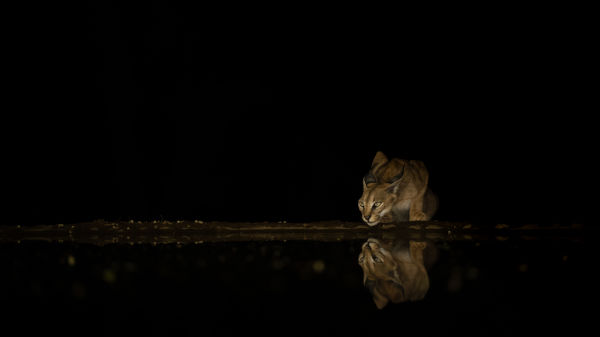
[A caracal watches warily as it approaches a waterhole]
This journey had begun rather inconspicuously almost twenty years back.
A colleague and I decided to extend a work trip to Beijing to explore the city a bit. A few more colleagues joined in and one of the trips planned was a 10 km hike on the Great Wall. It was not to the usual sanitized place that tourists go to, but to a much less frequented spot where the hills stretched all around us, in the usual undulating manner that hills are prone to.
There were spots where the wall had completely disintegrated, places where the steps were so steep that we had to climb up on all fours. If any of us had even twisted an ankle, let alone have a serious injury, we would have been in a serious mess considering how far away we were from help.
By the end of the hike, I was hooked. The outdoor bug had resurfaced in me.
I was a complete outdoor person till I finished college. A strange and alarming sense of responsibility descended on me once I started working and I seamlessly transitioned into being an out and out workaholic. Twelve, fourteen hour days became the norm and everything could happily be the sacrificial lamb at the altar of work.
But, now, I wanted to hit the mountains. I wanted to spend time outdoors, challenging myself physically, while soaking in the sights around me. It wasn’t easy to leave for the mountains. I had a young family I wanted to spend time with. There was, of course, work and the urge to climb the corporate ladder where vanishing and staying incommunicado for a couple of weeks every year was never an easy choice.
However, as I started making these trips, I was also realizing that these breaks were helping me in more ways than one. I was, of course, enjoying being outdoors, I was definitely getting the ego boost out of knowing that I was fit enough to do what I was doing, but there was something more. I was returning each time, feeling refreshed, a lot more invigorated and looking forward to work.
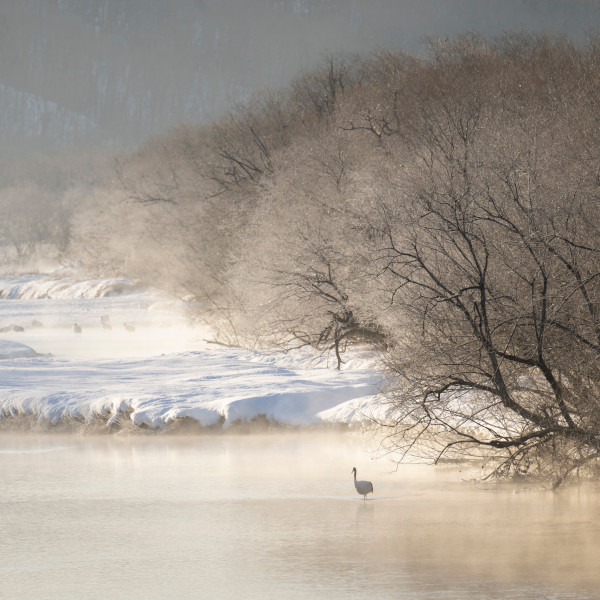
[Mist and sunrise in Hokkaido, Japan. A sole red-crowned crane goes fishing]
I realized that the Japanese have a term for this.
Shinrin yoku.
Forest bathing.
Forest bathing is to walk into the nearest forest or woods and spend time just soaking up the sounds of Nature. The bird calls, the sound of running water, the noisy crickets.
Forest bathing is also to breathe in the clean air, look up at the trees reaching out to the sky. It is to feel the soft grass under your feet, run your hands over a mossy tree trunk.
Forest bathing has become an important part of preventive healthcare in Japan. It calms you, it de-stresses you. It has been shown to improve the quality of sleep, the ability to focus and improves the overall mood.
I could experience all of these after each trek or outdoor expedition.
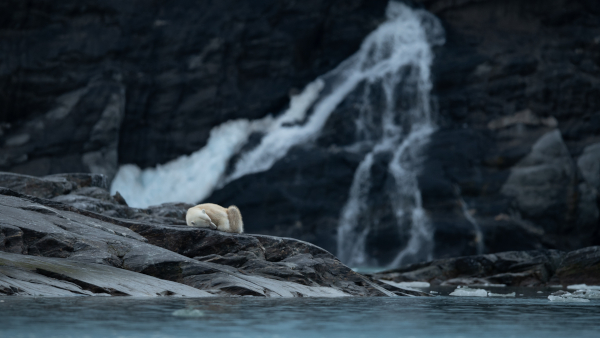
[Trust and tranquility. A polar bear takes a nap right in front of us. Her two cubs were playing a little distance away]
We don’t do this enough. Of late, doctors are pointing to a ‘nature deficit disorder’. The term was coined in 2005 by Richard Louv and was not meant to be a medical diagnosis. It referred to how a host of reasons, like poor urban planning, lack of open spaces, a proliferation of electronic devices, information overload leads to less time spent outdoors, amidst nature, causing a significant impact.
Scientific evidence now points to a reduced usage of the senses, an attention disorder, higher levels of aggression, higher rates of depression and a lower sense of well being.
It also helps in solving problems.
It is said that solutions tend to elude you when you are actively searching for them. It is often when you are not focusing on a specific problem that solutions spring up. It is when the mind roams aimlessly, flitting from topic to topic in a distracted manner, that we are struck by solutions to problems that have been vexing us. That’s possibly why all of us have got some good ideas while we are in the shower. There is nothing to distract you while you are taking a shower. That blessed mobile phone is definitely not there ceaselessly throwing content in your face.
Or we could step outdoors. Walk in a park, or go for a hike, without staring into the phone.
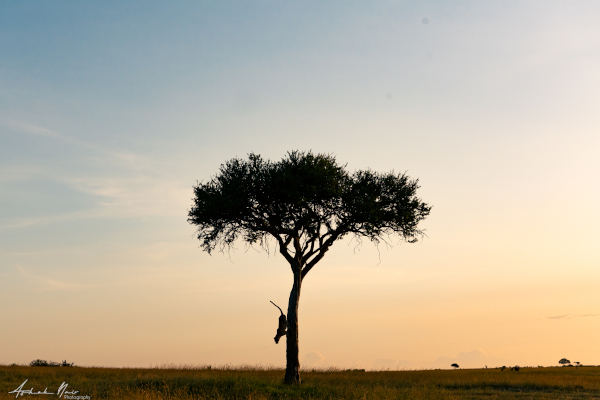
[Off on a hunt, a leopard strikes a silhouette against a gorgeous African sky]
A realisation that came to me while in the Himalayas changed my life.
The trek to Auden’s Col, a high-altitude pass in the Garhwal Himalayas, is a remote and demanding trek and I had long wanted to do this trek because of the physical challenge it promised. I started this trek with a vague sense of disquiet, the reasons for which I was not able to put my finger on. During those long solo walks through the jaw dropping beauty of the Himalayas, a realisation started dawning on me.
I had just landed myself a role that I had long aspired for and had just finished a record quarter. Still something was nagging me. Despite the highs of a record first quarter, I felt little joy or any feeling of accomplishment. My mind was focused on the challenges that lay ahead. The feeling of being caught up in the relentlessness of the corporate treadmill was going through my mind and out in the mountains, I started wondering if I needed more from life than endlessly chasing business growth. The light at the end of the tunnel seemed to be a myth. There is always a quarter to take care of after the current one. The thought that the corporate race is a race that has no finish line seemed extremely depressing.
I was not clear about what I should do, but the corporate success that I had been chasing for more than two decades suddenly ceased to hold much of a charm for me. The objective shifted to creating a reasonable amount of wealth which will allow me the option of doing what I really wanted to do.
I was fine with the lack of clarity of what exactly I would want to do.
I think, if you keep doing what you enjoy doing and keep your mind open for all the small little rabbit holes that appear along the way, sooner or later you will find what you would want to devote more time to.
I had started going on treks. I started long distance running, finding it a useful goal to keep myself fit. I bought myself a cycle, started cycling and later an Enfield Thunderbird 500 with the dream of biking across the country. I flitted in and out of these rabbit holes, some lasting a little longer than the others.
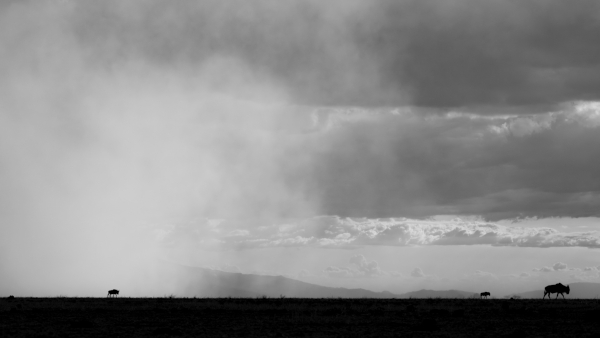
[Three wildebeests trudge in a typically determined way as a dust storm rages behind them]
The one new interest that stayed with me was photography.
I used to take a small point-and-shoot digital camera on my treks and I enjoyed the process of composition enough to feel tempted to learn a little more about the technicalities and bought an entry-level DSLR Nikon.
As a hobby, it took its time to settle down but when it did, I became obsessed. I started voraciously reading and watching countless YouTube videos and was fascinated by the wealth of knowledge that I came across—on photography as well as about wildlife which was the genre that attracted me the most.
Nature is fascinating in ways that I am still discovering.
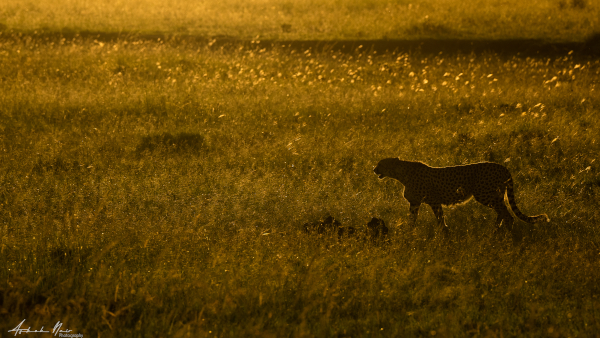
[The setting sun sets the grass on fire and a cheetah dances around it]
I learnt that female bears can decide whether to start their pregnancy or terminate it, depending on their fat reserves. That beluga whales have such a strong social structure that when a calf is born, ALL females in the group start lactating. The fact that migrating humpback whales stray less than one degree from their migration path blew my mind.
While I wanted to learn more about the wild, all this new found knowledge was also igniting a burning desire in me to be out there in the wild and experience this closer.
I stayed close to a cheetah mom who had lost a cub to the hyenas for an entire day. I watched how another cheetah mom sent her cubs scurrying into the undergrowth when she spied a lioness strolling in her direction and how she lured the lioness away in another direction by offering herself as a tempting target. I watched a male polar bear chase a female and wondered if he was chasing her away from a nearby dead walrus or to mate with her.
These were new experiences and learnings that I had never chanced upon earlier and I absolutely loved them.
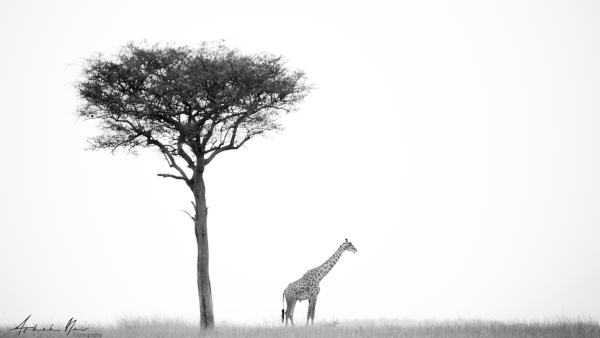
[The Giraffe and the Tree]
Wildlife photography taught me things removed from nature too.
One of them was respecting different perspectives.
If you are sharing your vehicle with other photographers, it is a given that all of you will take different photographs of the same scene in front of you. Some might zoom in for a close up, others might go wider, some might take it from the window of the vehicle, while others might lean out and try to take a ground level shot. We look at each other’s work and then each of us will mentally decide if that other perspective was a better one or if we would prefer the one that we had.
It struck me that we rarely take such a generous and liberal position at work or in life.
When you are out in the wild there are a lot of things that are not in your control. The appearance of the subject. The weather. The light. You don’t fret about what you can’t control.
You embrace the constraints.
Raining? Can you try slow shutter and have some fun with those raindrops? Snowing? Ditto. Too bright? Can you try something artistic through overexposure? Too dark? Can you use that sliver of light to create something interesting by underexposing even more?
It taught me not to moan about what I can’t control. To instead, focus on what is in my control and use it imaginatively.
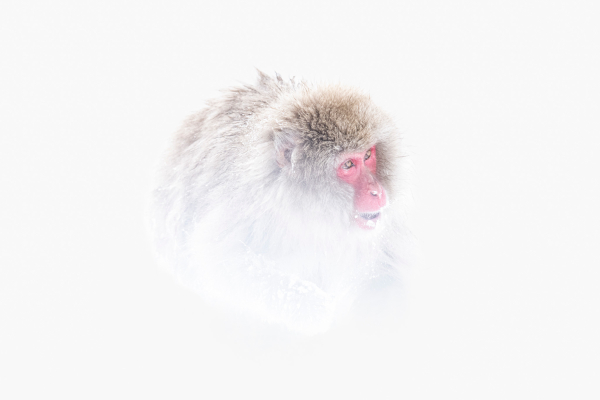
[A Japanese macaque keeps an eye out for a bigger male]
My readings introduced me to Twyla Tharp’s book, The Creative Habit, where she asked, what is your focal length?
Her point was that each of us is comfortable with a particular ‘focal length’. We either zoom in on the details, worrying about the nitty-gritty or we are more comfortable with the big picture and do not focus on the details. If we are aware of our natural tendency, we would be more conscious of the occasions when the other focal length would be needed. Could I consciously use that approach at work?
Photography taught me the importance of breaking rules. Images don’t need to be sharp and well lit. Images don’t need to follow the famous Rule of Thirds.
Break them rules. Follow your heart. Experiment. Fearlessly.
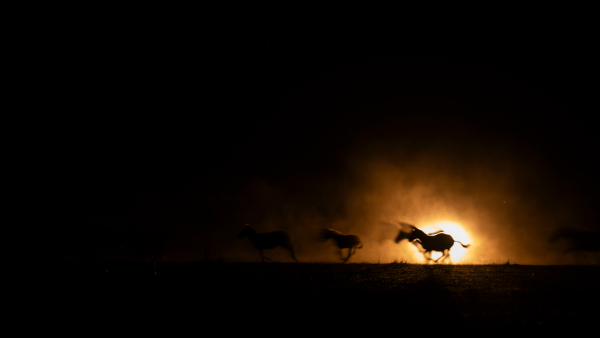
[Slow your shutter speed. Shoot against the light. Create something new about a running herd of zebras]
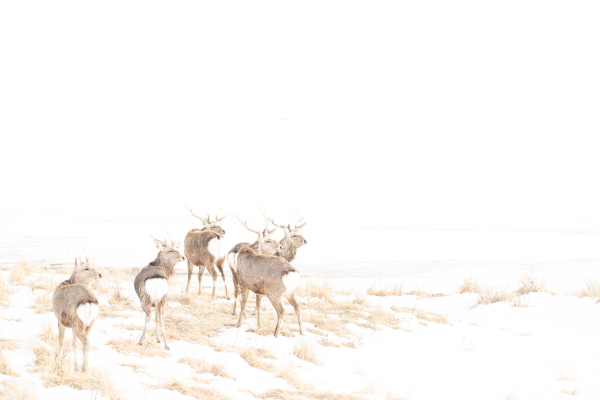
[Overexpose. Provide more negative space. Capture the tension of the sika deer turning back anxiously]
Above all, wildlife photography taught me that the real joy is in the moment. That while I am out there with my camera and a list of goals in my mind of the type of images I would want to create, the real satisfaction is in being outdoors, in experiencing the wilderness.
That a good photo is a bonus. Goals are good, but the process is more fun.
I have learnt to keep the camera aside and soak in the moment. To feel free to choke up in wonder at the sight of a polar bear shaking all the water off and rolling in the snow, to gasp in awe as an enormous super tusker walks a few feet away from me, to chuckle at the sight of two rhino cubs running around madly in circles.
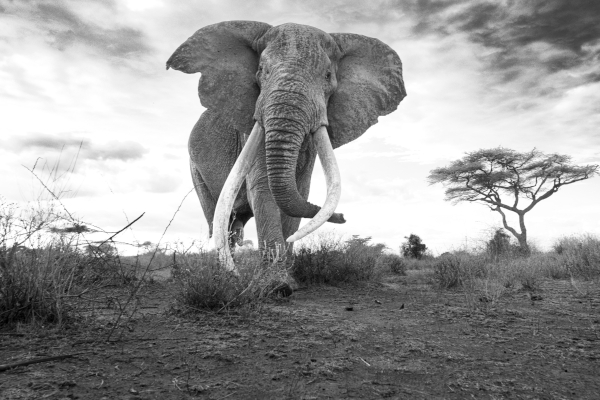
[The charge: Craig, a supertusker, walks past me, as I lay flat on the ground]
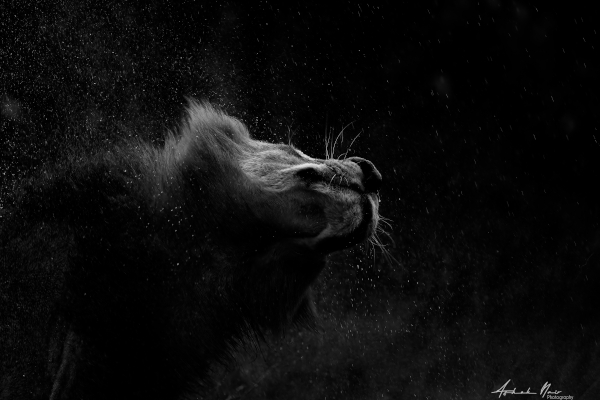
[A magnificent shake of a drenched royal head to get rid off all the water]
It is not necessary that to get your regular dosage of nature you need to head off to the nearest forest. It could be by simply taking a walk around your neighbourhood. It could be to go to the nearest park and sit under a tree.
Keep that phone aside. That WhatsApp message can be sent an hour later. That interesting podcast is not going to vanish anywhere.
Stay in the moment.
Look around you.
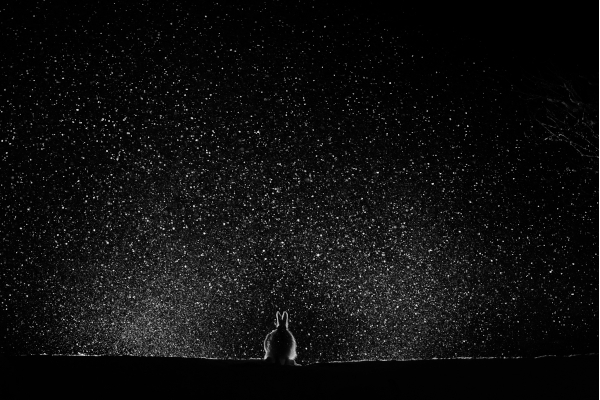
[A starry shower. A mountain hare seems stunned by the spectacle around it]
You could watch the dogs run around madly having fun. You could step on all the dried fallen leaves and enjoy the crunching sound. You could sit on a bench and smile at the squirrels playing tag. You could try to recognise the different bird calls around you.
When was the last time you walked in the rain?
Why not do it this monsoon?
[To read the story map on full screen, click here.]
